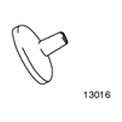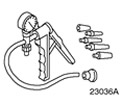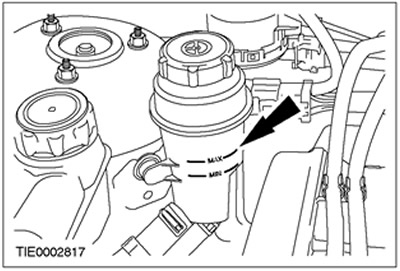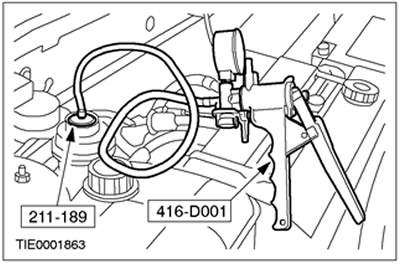Special tool
 | Adapter for removal of air from the power steering system 211-189 (13-016) |
 | Manual vacuum/pressure pump 416-D001 (23-036A) |
Air removal
1.
NOTE: When pouring working fluid into the reservoir, make sure the fluid is clean. Do not shake it before use. To reduce the level of saturation of the liquid with air, pour it into the reservoir slowly. The fluid level should be checked when the fluid is cold.
Pour liquid into the reservoir up to the mark "MAX".

2.
NOTE: Make sure the fluid level in the reservoir does not fall below the mark "MIN", because air may have entered the system.
Start the engine and slowly turn the steering wheel all the way to and fro.
3. Stop the engine and inspect the hose connections, steering gear boots, valve block, and pump for external leaks.
4. Check fluid level. If necessary, add the required amount of working fluid.
5.
NOTE: As air is removed from the system, the vacuum level will decrease. Maintain the vacuum at the prescribed level (51 kPa (15 inHg Art.)) using a manual vacuum/pressure pump. If the vacuum drops by more than 7 kPa (2 inHg Art.) within 5 minutes, you should check the system for leaks.
Remove air from the system. Use special tools.
- Start the engine and slowly turn the steering wheel once from lock to lock. Then turn the steering wheel to the right, almost to the full.
- Shut off the engine and use the manual vacuum/pressure pump to apply a vacuum of 51 kPa (15 inHg Art.). Maintain vacuum until all air is removed from the system (within 5 minutes minimum).
- Relieve the vacuum in the manual vacuum/pressure pump.
- Repeat the bleed procedure, this time turning the steering wheel to the left, almost all the way.

6. Remove the hand vacuum/pressure pump and plug. If necessary, add working fluid to the tank.
7. Start the engine, turn the steering wheel from lock to lock. If there is increased noise, repeat the bleed procedure.
8. If the noise level remains unacceptable, leave the vehicle overnight and then repeat the bleed procedure.
Visitor comments